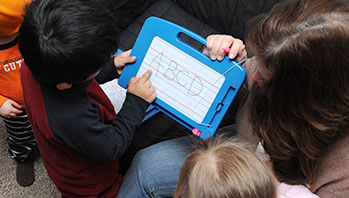- Between the Lions alphabet chart
- letter card “Dd”
- letter card “Ee”
- modeling clay
- pipe cleaners
- plastic straws
- curved
- straight
MA Standards:
Foundational Skills: RF.PK.MA.1.d: Recognize and name some uppercase letters of the alphabet and the lowercase letters in one’s own name.
Head Start Outcomes:
Literacy Knowledge/Alphabet Knowledge: Recognizes that the letters of the alphabet are a special category of visual graphics that can be individually named.
PreK Learning Guidelines:
English Language Arts/Reading and Literature 7: Develop familiarity with the forms of alphabet letters, awareness of print, and letter forms.
Letter Shaping (“Dd” and “Ee”)

© Commonwealth of Massachusetts, Department of Early Education and Care (Jennifer Waddell photographer). All rights reserved.
Skill Focus: Fine Motor Skills, Letter Formation, Letter Recognition, Vocabulary
Educator Prep: Before the activity, cut straw pieces into long and short pieces for making the letter "E."
Display the letter “Dd” card. Trace over both the lowercase and uppercase “Dd” to show children how to form the letters.
- When tracing the lowercase letter “d,” make the straight line first.
- Start at the top and pull down.
- Keep your hand at the bottom for a moment. Then move your hand part way back up the line, make a curve to the left and back to the bottom of the straight line.
- Model how to use the materials to shape the letters; then have children form their own letters.
Repeat the process with the letter “Ee.”
When tracing the lowercase letter “e,” make a short straight line that goes from left to right, then curve up and circle almost completely around the straight line.
Have children use the plastic straw pieces to form the uppercase letter “E.”
Ask, How many pieces do you think I will need to make the uppercase letter “E”? Which line is the longest?
English Language Learners: If children are having trouble understanding what is meant by straight and curved lines, draw examples for them or guide their fingers as they draw the lines themselves. Have children trace the drawn lines with their fingers as you have them say the words straight and curved.
